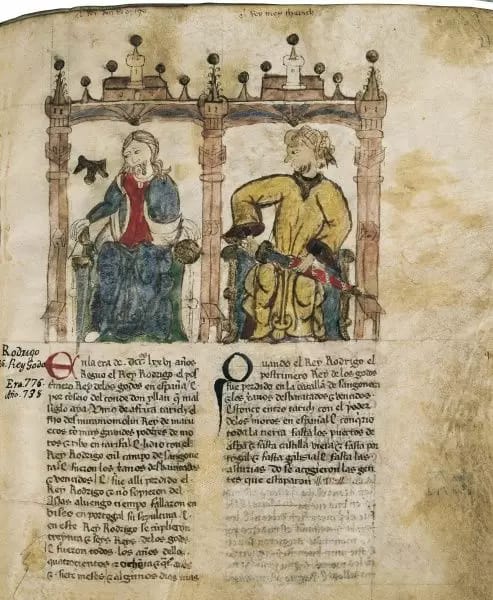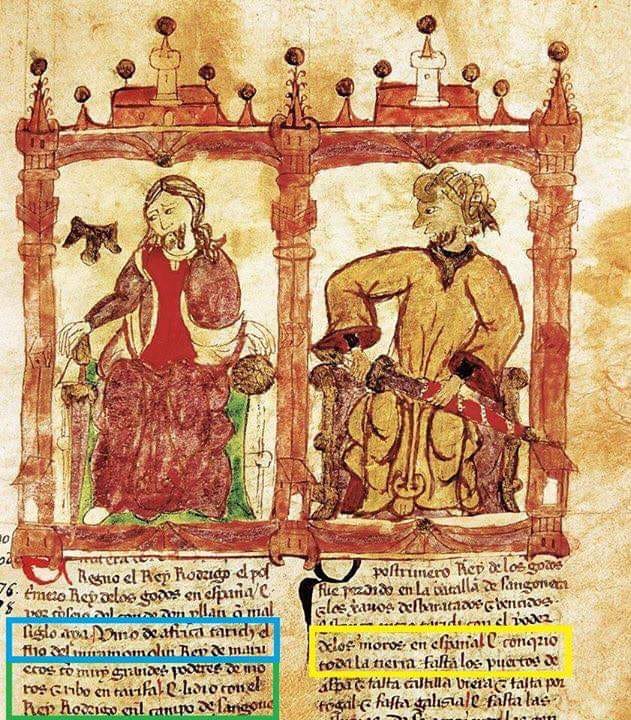| name | Tariq ibn Ziyad |
| place of birth | morocco |
| Date of birth and death | c 670-720 |
| His position | Governor of Tangier |
| His origin | Amazigh |

Tariq ibn Ziyad is one of the most prominent military leaders of all time, and is famous for leading the Islamic conquest of the Iberian Peninsula (Andalusia) in 711 AD. Tariq ibn Ziyad was born in 670 AD, and his origins are attributed to the Nafza tribe, the Amazigh (Berber) in North Africa, specifically in Morocco. Many people may confuse Nafza with the Tripolitanian Nafzawa in Libya, which has no connection to Tariq and his tribe, Nafza, which is located in northern Morocco. Ibn Adhari al-Marrakushi mentioned in his book, where he said after mentioning Tariq’s full name, “He is Nafzi,” and in his name there is an indication of another tribe, which is the Ben Yatoft tribe, which is the Ait Yatoft tribe, located in the Moroccan countryside, bordered to the east by the Ibqwin tribe and to the north by the Mediterranean coast.
There is no doubt that a rational and sensible person, upon examining the Islamic sources that addressed the topic of Al-Andalus, will find severe discrepancies—not only in their consistency with one another or the level of integrity maintained by the authors, but these narratives sometimes elevate themselves above reality to enter a metaphysical, imaginary world. In this world, leaders deliver speeches in languages that their armies do not understand before going into battle, destroy opportunities for tactical withdrawal with their own hands, and all the characters in that world possess Arab lineage without the slightest evidence!
However, the blame does not fall on the authors of these Arab-Islamic sources. Even though some of them were overtaken by laziness and neglect in fact-checking, we can forgive them because, in those times, these were the common methodologies in historiography. We will have to wait a long time before the appearance of Arabic writing that respects scientific research, under the hands of Ibn Khaldun. But the blame falls on the enthusiastic hordes who ride these narratives and foolishly employ them, either to claim Tariq ibn Ziyad as their own or to tarnish his image under the slogan “Either you share your history with me, or it is falsification and distortion.”
Here, we return to discussing the character of Tariq ibn Ziyad, clarifying his true lineage, and determining his social status—was he a governor? A military commander? Or merely a slave?
Here, we will rely on one of the most extensive works specializing in the history of the Iberian Peninsula. We are talking about the Gothic Chronicle attributed to Isidore. It is a chronicle in Latin with a Western Gothic script, recounting the history of Spain from its origins and Roman rule until the conquest by Tariq ibn Ziyad.
It is not authored by Isidore of Seville, as its name might suggest. The writing style and the appearance of literal translations of names and toponyms in Arabic form indicate that this chronicle is a Latin translation of an Arabic original composed by an unknown author, who compiled several Latin works, including: the Chronicle of Saint Jerome, the Seven Books of History by Orosius, the Gothic History by Isidore, the Mozarabic Chronicle of 754, and the Cosmography by Julius Honorius.
The chronicle is found in a single original manuscript preserved in the National Library of France. It was recovered in the 16th century by the academic Pierre Pithou, who brought it to Paris. Generally, it was found in southern France and is believed to have been written between the 10th and 12th centuries. The credit for its critical edition and reproduction goes to Theodor Mommsen in 1894.
This chronicle narrates the events of the conquest of Al-Andalus in its final sections and gives us a logical and remarkably consistent image with the 14th-century Gothic miniature, which we previously dedicated a full article to. We saw how it presented Tariq as one of the great figures with a social rank that reached the level of “king,” equating him with Roderic on the throne. It also contains a reference to the Moroccan ethnic origin of Tariq ibn Ziyad.
Now we move on to the desired excerpt:
“When they arrived, Kittiko told her how he brought himself and the girl (Julian’s daughter) to himself through deception… Thus, Julian gathered all his wealth of gold, silver, and clothes and rushed to the castle where King Tariq was and said: ‘Do you want to enter Spain? I will guide you, for I am the one who holds the keys to the land and the sea, and I can guide you well.’ Tariq said, ‘How do you expect me to trust you when I know you are a Christian while I am one of the Moors?’ Julian replied, ‘You can trust me because I will leave my wife, my children, and my countless wealth at your disposal.'”
“After accepting the guarantee, Tariq gathered a huge number of soldiers, coming with Julian to the island of Tarifa, between Malaga and Lepcis. He climbed a mountain that to this day is called Gibraltar, and there reached Hispalis with his army, laid siege to it, and then seized it.”
End of the excerpt!
We do not believe this passage requires much explanation as it is straightforward. But it is worth noting that Kittiko here is Witzia (Vitiza), who is known as Witiza, one of the kings of the Visigoths. The Lepcis mentioned is not Leptis Magna in Libya but an unknown site on the Iberian side of the Strait of Gibraltar.
As for the context, it seems that Tariq ibn Ziyad feared that Julian’s invitation was merely a trap set by the Visigoths, so he quickly sought guarantees from Julian after the latter asked him for help in recovering his daughter in exchange for assistance in the conquest of Spain. The chronicle also adds that the original name of Julian’s daughter was Ulba.
It is also evident that Tariq’s social rank was high, as shown by his being given the title of “King.” As for his origin, it is clear that Tariq identifies himself as a Moor. It is worth noting that the term “Moor” in this text refers specifically to the inhabitants of northwest Africa (Morocco), and it is impossible for it to be used to denote a Muslim because the Visigoths at that time did not yet know the Muslims. Moreover, it does not include the inhabitants of North Africa, as the author clearly distinguishes between Moroccan (Marrochinas) and African (Affricanas).

We must not confuse Tariq ibn Ziyad as portrayed by Eastern Arab narratives in Islamic stories with the Moroccan Moorish Berber Tariq described in Iberian documents and records since the 14th century, which describe him with remarkable accuracy as the son of the Commander of the Faithful and the son of the King of Morocco.
Western scholars, particularly Spanish ones, are certain of his Moroccan origin based on archaeological evidence that leaves no room for doubt. Moreover, they assert that he was the son of the King of Morocco without any specific allegiance to the Umayyads or Musa ibn Nusayr as mentioned in later traditions.
Among the oldest documents that mention the Moroccan leader Tariq ibn Ziyad, we find this European miniature from the book “Portraits of Kings,” dated to the 14th century, titled “Don Rodrigo, the Last King of the Visigothic Kingdom (671-711), and Tariq Ibn the Chief of the Moors.” This book is located in the National Library of Spain in Madrid. See the picture in the first comment.
This miniature bears text in ancient Spanish, with the names of two prominent figures, one Moroccan Berber and the other Gothic Iberian, clearly visible at the top of the image. On the left side, the name of the Gothic king Don Rodrigo, el rey don rodrigo, appears prominently.
In the blue frame, we find a reference to Count Julian, the ruler of Ceuta, who asked Tariq to help him retrieve his daughter, who was raped in Rodrigo’s court, in exchange for helping him seize Al-Andalus. In the green frame, we see rio del miramomolin rey de maruecos.
We also find the term miramomolin, which means Commander of the Faithful, and the phrase King of Morocco, rey de maruecos. The text also includes the phrase to mus grandes poderes de moros…tarifa, which translates to the supreme commander of the Moroccan army, with a mention of the city of Tarifa.
The complete passage is:
De Africa Tarich el fijo del miramomolin Rey de Marruecos fo muy grandes poderes de moros aribo en Tarifa
This can be translated as:
“From Africa, Tariq, the son of the Commander of the Faithful, King of Morocco, with great power and influence of the Moors, arrived at Tarifa.” This valuable document is written in ancient Spanish, where Fijo means son, which later became Hijo in modern Spanish.
In the yellow frame, there is a phrase referring to the Moroccan forces in Spain, con el poderes de los moros en Espana. With this, we close the chapter on Tariq’s origins, whether he was from present-day Algeria, Moorish Morocco, Libya, or the Arabian Peninsula.
This European miniature is considered the oldest document that references “Tariq,” which completely refutes the narrative that Tariq ibn Ziyad was a Mawla, meaning a slave, of the Umayyads. Instead, it describes him as the son of the Commander of the Faithful, King of Morocco, and the supreme commander of the Moroccan Moorish Berber army. He may even have been the crown prince!
